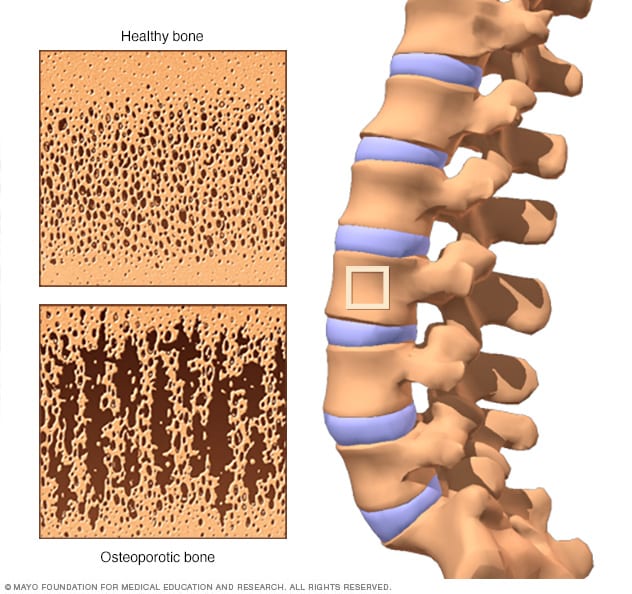
Osteoporosis
Osteoporosis is defined as spongy (porous) bone. It is a disease that causes your bones to become weaker thinner and less dense than they should be. Broken bones (bone fractures) are much more common in people who have osteoporosis.
Overview
Bone is an organic tissue that is constantly breaking down and being replaced. Old bone tissue is broken down by cells called osteoclasts and replaced with new bone formation through cells called osteoblasts. Generally, your bones are dense and solid enough to withstand your weight and take up most types of impacts. Your bones naturally lose some of their density and ability to regrow (remodel) themselves as you age. If you have osteoporosis, your bones are substantially more fragile than they should be.
Most people are unaware they have osteoporosis until they break a bone The balance between the disintegration of old bone and the development of new bone shifts throughout our lives. When the formation of new bone does not keep up with the reduction of old bone, osteoporosis develops. New bone is formed at a rapid rate during childhood and adolescence. This enables our bones to become larger and stronger (denser).
By our mid-to-late twenties, bone density has reached its peak. Following this, new bone is formed at roughly the same rate as old bone is broken down. This implies that the adult skeleton is completely renewed every 7-10 years. Men and women of all races are affected by osteoporosis. However, white and Asian women, particularly older women who have passed menopause are most vulnerable. Medicines a healthy diet and rigorous physical activity can help prevent bone loss or reinforce bones that are already weak.
Causes
The mass of bones is lost faster than it is created as people age. The amount of bone mass you had when you were younger influences your risk of developing osteoporosis. Some osteoporosis risk factors are beyond your control, such as:
Your sexuality: Women are far more likely than men to develop osteoporosis.
Age: The older you get, the more likely you are to develop osteoporosis.
Race: You are most likely to develop osteoporosis if you are white or of Asian descent.
A family tree: Having an osteoporotic parent or sibling increases your risk, especially if your mother or father fractured a hip.
Size of the body frame: Men and women with small body frames are more vulnerable because they may have less bone mass to draw from as they age.
Other factors that contribute to bone loss include:
Hormones like thyroid imbalance
Nutritional deficiencies like low calcium intake
Usage of steroids
Gastritis with reflux
Celiac diseases like IBS / colitis
Liver or kidney diseases
Cancers
Sedentary lifestyle
Alcohol consumption
Symptoms
Osteoporosis is frequently asymptomatic. However, once your bones have been weakened by osteoporosis, you may experience them. The first sign of osteoporosis is when you break a bone in an unintentional fall or accident (known as a low-impact fracture). Fractures are most commonly found in the hip spine or wrist. The following are the other signs and symptoms:
• Back pain caused by broken or collapsed vertebrae.
• Height loss over time.
• A hunched posture.
• A bone that fractures far more easily than expected.
• Body Pain
Ayurvedic View
Asthi shoushiriya- here kshaya means swapramana hani (decrease or loss in the quantitative aspect, some also describe it as swa guna kriya nasha means here guna and karma (function aspect) of asthi dhatu (bone tissue) is affected. Its all because of prakupita vata dosha which takes sthana samshraya (settles) in asthi dhatu (bone tissue), causes Shoshana (depletion or drying of nutrition) by its ruksha (drying property)and khara guna (roughness). Here shoushiriya means sarandratvam (with pores), which is caused due to vata (wind element) and aakash (ether element). Patient has sandhi ruja (bone pain), lack of strength is osteoporosis. Ayurveda way of approach is to correct agni (metabolism), bring dosha back to prakruta awastha (balance state), improve the functioning of bony joint and prevent further complication arising in this condition by ayurvedic panchakarma treatment, which nourishes the asthi dhatu.
Ayurvedic Treatments
Patra pinda swedanam Churna pinda swedanam Pinda swedanam Lepanam Vasti Pichu Pizhichil Navara pinda swedanam Upanaham Abhyangam
Naturopathy Treatments
Enema Manipulative therapy Steam bath Mud therapy Chromotherapy Magnetotherapy Diet therapy Clinical yoga Pranayama Exercise therapy Packs
Osteoporosis
Treatment for
DISCLAIMER: Listed treatment details are only for information purposes. Treatments and duration may vary depending on numerous factors. Treatments for your condition may not be limited to this list.






















